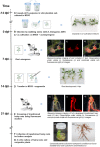Hairy Root Transformation: A Useful Tool to Explore Gene Function and Expression in Salix spp. Recalcitrant to Transformation
- PMID: 31781143
- PMCID: PMC6859806
- DOI: 10.3389/fpls.2019.01427
Hairy Root Transformation: A Useful Tool to Explore Gene Function and Expression in Salix spp. Recalcitrant to Transformation
Abstract
Willow (Salix spp. L.) species are fast-growing trees and shrubs that have attracted emergent attention for their potential as feedstocks for bioenergy and biofuel production, as well as for pharmaceutical and phytoremediation applications. This economic and environmental potential has propelled the creation of several genetic and genomic resources for Salix spp. Furthermore, the recent availability of an annotated genome for Salix purpurea has pinpointed novel candidate genes underlying economically relevant traits. However, functional studies have been stalled by the lack of rapid and efficient coupled regeneration-transformation systems for Salix purpurea and Salix spp. in general. In this report, we describe a fast and highly efficient hairy root transformation protocol for S. purpurea. It was effective for different explant sources and S. purpurea genotypes, with efficiencies between 63.4% and 98.7%, and the screening of the transformed hairy roots was easily carried out using the fluorescent marker DsRed. To test the applicability of this hairy root transformation system for gene functional analysis, we transformed hairy roots with the vector pGWAY-SpDRM2, where the gene SpDRM2 encoding a putative Domain Rearranged Methyltransferase (DRM) was placed under the control of the CaMV 35S constitutive promoter. Indeed, the transgenic hairy roots obtained exhibited significantly increased expression of SpDRM2 as compared to controls, demonstrating that this protocol is suitable for the medium/high-throughput functional characterization of candidate genes in S. purpurea and other recalcitrant Salix spp.
Keywords: Agrobacterium rhizogenes-mediated transformation; Salix purpurea; domains rearranged methyltransferase 2 (DRM2); pGWAY-0; willow.
Copyright © 2019 Gomes, Dupas, Pagano, Grima-Pettenati and Paiva.
Figures


Similar articles
-
Highly efficient Agrobacterium rhizogenes-mediated hairy root transformation for gene functional and gene editing analysis in soybean.Plant Methods. 2021 Jul 10;17(1):73. doi: 10.1186/s13007-021-00778-7. Plant Methods. 2021. PMID: 34246291 Free PMC article.
-
Highly efficient Agrobacterium rhizogenes-mediated hairy root transformation in citrus seeds and its application in gene functional analysis.Front Plant Sci. 2023 Oct 31;14:1293374. doi: 10.3389/fpls.2023.1293374. eCollection 2023. Front Plant Sci. 2023. PMID: 38023879 Free PMC article.
-
Protoplast-Based Transient Expression and Gene Editing in Shrub Willow (Salix purpurea L.).Plants (Basel). 2022 Dec 13;11(24):3490. doi: 10.3390/plants11243490. Plants (Basel). 2022. PMID: 36559601 Free PMC article.
-
Highly efficient Agrobacterium rhizogenes-mediated transformation for functional analysis in woodland strawberry.Plant Methods. 2023 Sep 23;19(1):99. doi: 10.1186/s13007-023-01078-y. Plant Methods. 2023. PMID: 37742022 Free PMC article.
-
Hairy root biotechnology--indicative timeline to understand missing links and future outlook.Protoplasma. 2015 Sep;252(5):1189-201. doi: 10.1007/s00709-015-0761-1. Epub 2015 Jan 28. Protoplasma. 2015. PMID: 25626898 Review.
Cited by
-
Agrobacterium rhizogenes: paving the road to research and breeding for woody plants.Front Plant Sci. 2023 Nov 14;14:1196561. doi: 10.3389/fpls.2023.1196561. eCollection 2023. Front Plant Sci. 2023. PMID: 38034586 Free PMC article. Review.
-
Agrobacterium rhizogenes-Mediated Hairy Root Genetic Transformation Using Agrobacterium Gel Inoculation and RUBY Reporter Enables Efficient Gene Function Analysis in Sacha Inchi (Plukenetia volubilis).Int J Mol Sci. 2025 Mar 11;26(6):2496. doi: 10.3390/ijms26062496. Int J Mol Sci. 2025. PMID: 40141141 Free PMC article.
-
An Efficient Agrobacterium rhizogenes-Mediated Hairy Root Transformation Method in a Soybean Root Biology Study.Int J Mol Sci. 2022 Oct 14;23(20):12261. doi: 10.3390/ijms232012261. Int J Mol Sci. 2022. PMID: 36293115 Free PMC article.
-
Phytoremediation: a transgenic perspective in omics era.Transgenic Res. 2024 Aug;33(4):175-194. doi: 10.1007/s11248-024-00393-x. Epub 2024 Jun 26. Transgenic Res. 2024. PMID: 38922381 Review.
-
Highly efficient Agrobacterium rhizogenes-mediated hairy root transformation for gene editing analysis in cotton.Front Plant Sci. 2022 Dec 23;13:1059404. doi: 10.3389/fpls.2022.1059404. eCollection 2022. Front Plant Sci. 2022. PMID: 36643290 Free PMC article.
References
LinkOut - more resources
Full Text Sources
Miscellaneous

